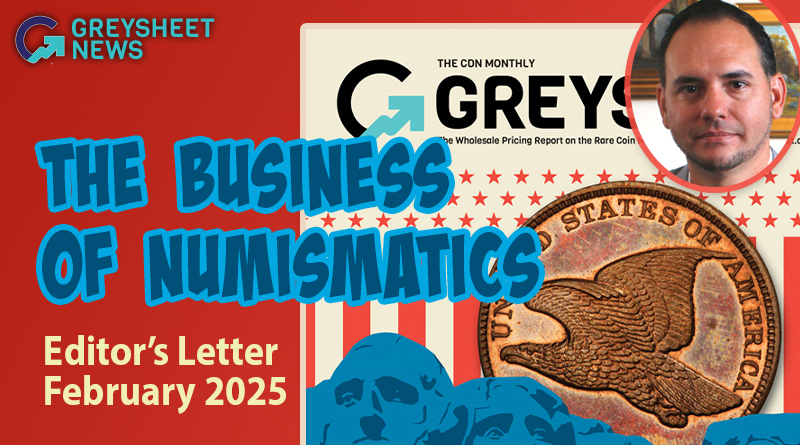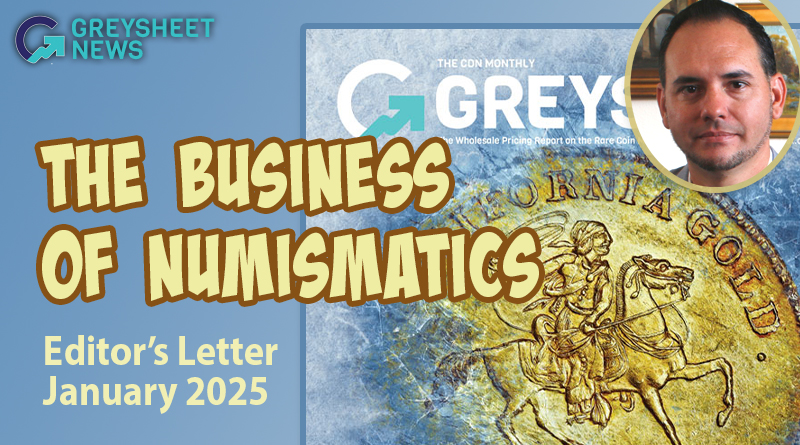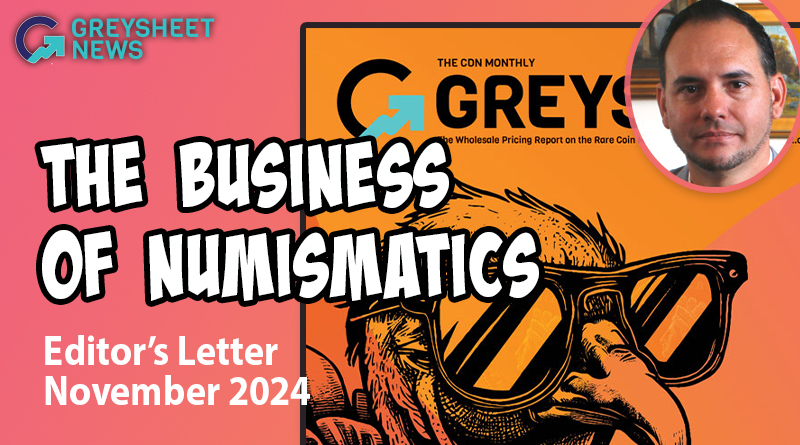The Business of Numismatics: February 2025 Greysheet Editor's Letter
Now that we have the full postmortem on 2024, the numbers are both historic and provide meaningful insight on what can be expected this year.
At year’s end, the S&P 500 index was up by 23.3%, with these gains pared by a December decline of 2.5%. The Dow Jones Industrial Average was plus 12.9% on the year, while the S&P MidCap 400 and SmallCap 600 was up 12.2% and 6.8%, respectively. This brings the two-year gain of the S&P 500 to a very strong 53.2%, the biggest 24 month gain since 1998. Importantly, the S&P 500 constituent companies paid out a record $630 million in dividends to shareholders. This dividend income surely fuels some purchases in the collectibles market.
Gold and Bitcoin (BTC) also had huge years in 2024, and this correlation has been increasingly studied. Several years ago BTC was being touted as the “new gold,” only for the volatility and other regulatory issues scare off many retail buyers. The price action of both gold and BTC in 2024 is obviously a result of significant demand. A solid statistic is the percentage of gold as a part of overall portfolio holdings globally, which at the end of 2024 approached 3%, with prior years being as low as 1.6%. While this may seem like a low percentage, this is relative to all of the equities, bonds, and cash held by investors, which is an absolutely massive number. The buying of gold and BTC can be termed the “debasement trade,” as it is a reaction to the large increase in the money supply, and thus, inflation. More individuals realize the decline of the purchasing power of fiat currency, and have invested accordingly. Since BTC future contracts are now tradable, market data allows more accurate comparisons to gold. Open interest, which is the main method to measure commodity demand, on BTC went from less than $18 billion in January to $55 billion by December. The two assets share many commonalities. Gold was for hundreds of years a medium of exchange, but you will find no one today using gold for a purchase. Gold is also not necessarily a collectible, although many people collect gold coins and buy gold watches and gold jewelry. It is an investible asset, and its value, or price, is set by market trading. Likewise, Bitcoin was conceived as a decentralized medium of exchange, and while some things can be bought with it, it has thus far not achieved this goal. Also, people do not collect BTC, although there is a market for physical remnants of early BTC. It is an investible asset whose price is set by market trading.
So where does this debasement trade trend leave the rare coin market. The reality is that the coin market has benefitted from the inflating of paper money for the past three years; it does not make a market savant to tell you that. Fortunately, this continued shift to physical investments will ensure that coins will continue to be in demand, especially for coins valued at $1,000 or greater. The primary issue, once again, is supply. Many rare coins are going into strong hands who have no plans of selling for a long time. Dealers will have to be intrepid in their seeking of fresh material, including expanding into world coinage. As can be explored in the News section of greysheet.com/news, there are new releases almost daily from mints around the world. 2025 is certainly a year in which the numismatic market can outperform the wider economy.
Sincerely,
Patrick Ian Perez, patrick@whitmanbrands.com

Download the Greysheet app for access to pricing, news, events and your subscriptions.
Subscribe Now.

Subscribe to The Greysheet for the industry's most respected pricing and to read more articles just like this.
Author: Patrick Ian Perez












Please sign in or register to leave a comment.
Your identity will be restricted to first name/last initial, or a user ID you create.
Comment
Comments